The Renewable Energy Communities in Italy and the Role of Public Administrations: The Experience of the Municipality of Assisi between Challenges and Opportunities
Abstract
:1. Introduction
2. Literature Review and Aim of the Work
3. Case of the Study
3.1. Energy Transition of the Municipality of Assisi
3.2. Renewable Energy Installations: State of the Art and Development Trends
4. Methodology
4.1. Rationale
- The dissemination of renewable sources in the municipal energy mix;
- The installation of energy storage systems and the increase of self-consumption from renewable energy sources;
- The dissemination of home automation (smart meters, digital meters, control and management platforms) and the consequent optimization of consumption profiles;
- The transition towards sustainable mobility (charging stations and electric vehicles);
- The active involvement of citizens in the energy transition, as consumers, energy producers, or both (prosumers).
4.2. Choice of Clusters and Configuration
4.3. Energy Analysis
- Physical self-consumption index: the ratio between physical self-consumption and photovoltaic production.
- Virtual self-consumption index: the ratio between the energy shared among community members and the total photovoltaic production.
- Total self-consumption index: the sum of the physical self-consumption index and the virtual self-consumption index. Since both terms in this index have the energy produced by the REC in the denominator, this index provides insights into how effectively the configuration utilizes the overall energy production.
- Energy self-sufficiency index: the sum of physical self-consumption and shared energy divided by total energy consumption.
4.4. Economic Analysis
- Electricity fed into the grid “RID” (Ritiro Dedicato): paid by the GSE for selling electricity to the grid, conservatively assumed to be the minimum guaranteed price, albeit variable over the lifespan of the REC, at EUR 40.7/MWh [40].
- Physical self-consumption: corresponding to the savings from not purchasing electricity from the grid, estimated at EUR 300.0/kWh.
- Energy shared within the REC (energy shared: the minimum on an hourly basis between the energy generated by renewable sources and the energy consumed by the REC members from the grid):
- Annual incentive paid by the GSE for shared energy: The incentive paid by the GSE to the REC (CACV) has a duration of 20 years and is directly proportional to the shared energy (EACV). Pending the Decree of the Italian Ministry of Environment and Energy Security (MASE) that establishes the incentive values in implementation of Legislative Decree 199/21, reference was made to the currently applicable transitional regime, which corresponds to an amount of EUR 110.0/kWh.
- Compensation related to ARERA refunds: Refund of the transmission tariff (TRASE) defined for low-voltage users and the higher value of the variable distribution component for other low-voltage users. Referring to the values set by ARERA for low-voltage users for 2023, they are considered as EUR 8.48/MWh and EUR 0.61/MWh, respectively, for a total of EUR 9.09/MWh.
- The total value of incentives and compensation considered for the valuation of shared energy is, therefore, EUR 119.09/MWh.
5. Results
5.1. Energy Results
5.2. Economic Results
6. Discussion
6.1. Revenue Sensitivity
6.2. Shared Energy Index
6.3. Potential of the Model and Replicability
7. Conclusions
Author Contributions
Funding
Institutional Review Board Statement
Informed Consent Statement
Data Availability Statement
Acknowledgments
Conflicts of Interest
References
- Mišík, M.; Nosko, A. Post-pandemic lessons for EU energy and climate policy after the Russian invasion of Ukraine: Introduction to a special issue on EU green recovery in the post-COVID-19 period. Energy Policy 2023, 177, 113546. [Google Scholar] [CrossRef] [PubMed]
- Cassetti, G.; Boitier, B.; Elia, A.; Le Mouël, P.; Gargiulo, M.; Zagamé, P.; Nikas, A.; Koasidis, K.; Doukas, H.; Chiodi, A. The interplay among COVID-19 economic recovery, behavioural changes, and the European Green Deal: An energy-economic modelling perspective. Energy 2023, 263, 125798. [Google Scholar] [CrossRef] [PubMed]
- Ferriani, F.; Gazzani, A. The impact of the war in Ukraine on energy prices: Consequences for firms’ financial performance. Int. Econ. 2023, 174, 221. [Google Scholar] [CrossRef]
- Kuzemo, C.; Blondeel, M.; Dupont, C.; Brisbois, M.C. Russia’s war on Ukraine, European energy policy responses & implications for sustainable transformations. Energy Res. Soc. Sci. 2023, 93, 102842. [Google Scholar]
- Cui, L.; Yue, S.; Nghiem, X.; Duan, M. Exploring the risk and economic vulnerability of global energy supply chain interruption in the context of Russo-Ukrainian war. Resour. Policy 2023, 81, 103373. [Google Scholar] [CrossRef]
- UN General Assembly. Transforming Our World: The 2030 Agenda for Sustainable Development, 21 October 2015, A/RES/70/1, United Nations. Available online: https://sdgs.un.org/sites/default/files/publications/21252030%20Agenda%20for%20Sustainable%20Development%20web.pdf (accessed on 30 May 2023).
- European Commission. Fit for 55: Delivering the EU’s 2030 Climate Target on the Way to Climate Neutrality. 2021. Available online: https://eur-lex.europa.eu/legal-content/EN/TXT/HTML/?uri=CELEX:52021DC0550&from=EN (accessed on 30 May 2023).
- Khan, H.; Weili, L.; Bibi, R.; Khan, I. Innovations, energy consumption and carbon dioxide emissions in the global world countries: An empirical investigation. J. Environ. Sci. Econ. 2022, 4, 1225. [Google Scholar] [CrossRef]
- Raihan, A.; Chandra Voumik, L. Carbon Emission Dynamics in India Due to Financial Development, Renewable Energy Utilization, Technological Innovation, Economic Growth, and Urbanization. J. Environ. Sci. Econ. 2022, 4, 3650. [Google Scholar] [CrossRef]
- Jamil, M.N. Critical Analysis of Energy Consumption and Its Impact on Countries Economic Growth: An empirical analysis base on Countries income level. J. Environ. Sci. Econ. 2022, 2, 112. [Google Scholar] [CrossRef]
- Tatti, A.; Ferroni, S.; Ferrando, M.; Motta, M.; Causone, F. The Emerging Trends of Renewable Energy Communities’ Development in Italy. Sustainability 2023, 15, 6792. [Google Scholar] [CrossRef]
- Zatti, M.; Moncecchi, M.; Gabba, M.; Chiesa, A.; Bovera, F.; Merlo, M. Energy communities design optimization in the Italian framework. Appl. Sci. 2021, 11, 5218. [Google Scholar] [CrossRef]
- Lode, M.L.; Boveldt, G.; Coosemans, T.; Camargo, L.R. A transition perspective on Energy Communities: A systematic literature review and research agenda. Renew. Sustain. Energy Rev. 2022, 163, 112479. [Google Scholar] [CrossRef]
- Bovera, F.; Lo Schiavo, L. From energy communities to sector coupling: A taxonomy for regulatory experimentation in the age of the European Green Deal. Energy Policy 2022, 171, 113299. [Google Scholar] [CrossRef]
- Legambiente. Legambiente Rapporto Comunità Rinnovabili 2022; Legambiente: Rome, Italy, 2022. [Google Scholar]
- Krug, M.; Rosaria, M.; Nucci, D.; Caldera, M.; De Luca, E. Mainstreaming Community Energy: Is the Renewable Energy Directive a Driver for Renewable Energy Communities in Germany and Italy? Sustainability 2022, 14, 7181. [Google Scholar] [CrossRef]
- Haji Bashi, M.; De Tommasi, L.; Le Cam, A.; Relaño, L.S.; Lyons, P.; Mundó, J.; Pandelieva-Dimova, I.; Schapp, H.; Loth-Babut, K.; Egger, C.; et al. A review and mapping exercise of energy community regulatory challenges in European member states based ona survey of collective energy actors. Renew. Sustain. Energy Rev. 2023, 172, 113055. [Google Scholar] [CrossRef]
- EU Directive (EU). 2018/2001 of the European Parliament and of the Council of 11 December 2018 on the Promotion of the Use of Energy from Renewable Sources (Recast). Off. J. Eur. Union 2018, 2018, 82–209. [Google Scholar]
- European Parliament. Council of the European Union Directive (EU) 2019/944 on Common Rules for the Internal Market for Electricity and Amending Directive 2012/27/EU. Off. J. Eur. Union 2019, 18, 27–28. [Google Scholar]
- European Commission Clean Energy for All Europeans Package. Available online: https://energy.ec.europa.eu/topics/energy-strategy/clean-energy-all-europeans-package_en (accessed on 30 May 2023).
- Decreto Legge. 30 Dicembre 2019, n. 162. Coordinato con la Legge di Conversione 28 Febbraio 2020, n. 8, Recante: ‘Disposizioni Urgenti in Materia di Proroga di Termini Legislativi, di Organizzazione delle Pubbliche Amministrazioni, Nonché di Innovazione Tecnologica’; Gazzetta Ufficiale della Repubblica Italiana: Rome, Italy, 2019. [Google Scholar]
- Decreto Legislativo. 8 Novembre 2021, n. 199. Attuazione della Direttiva (UE) 2018/2001 del Parlamento Europeo e del Consiglio, dell’11 Dicembre 2018, Sulla Promozione dell’uso Dell’energia da Fonti Rinnovabili; Gazzetta Ufficiale Della Repubblica Italiana: Rome, Italy, 2021. [Google Scholar]
- GSE. Energia e Clima in Italia—Rapporto Trimestrale Q4/2022–2023. Available online: https://www.gse.it/dati-e-scenari/rapporti (accessed on 30 June 2023).
- Tarpani, E.; Piselli, C.; Fabiani, C.; Pigliautile, I.; Kingma, E.J.; Pioppi, B.; Pisello, A.L. Energy Communities Implementation in the European Union: Case Studies from Pioneer and Laggard Countries. Sustainability 2022, 14, 12538. [Google Scholar] [CrossRef]
- Cirone, D.; Bruno, R.; Bevilacqua, P.; Perrella, S.; Arcuri, N. Techno-Economic Analysis of an Energy Community Based on PV and Electric Storage Systems in a Small Mountain Locality of South Italy: A Case Study. Sustainability 2022, 14, 13877. [Google Scholar] [CrossRef]
- Ceglia, F.; Esposito, P.; Faraudello, A.; Marrasso, E.; Rossi, P.; Sasso, M. An energy, environmental, management and economic analysis of energy efficient system towards renewable energy community: The case study of multi-purpose energy community. J. Clean. Prod. 2022, 369, 133269. [Google Scholar] [CrossRef]
- Efthymiou, E.N.; Yfanti, S.; Kyriakarakos, G.; Zervas, P.L.; Langouranis, P.; Terzis, K.; Stavrakakis, G.M. A Practical Methodology for Building a Municipality-Led Renewable Energy Community: A Photovoltaics-Based Case Study for the Municipality of Hersonissos in Crete, Greece. Sustainability 2022, 14, 12935. [Google Scholar] [CrossRef]
- Hoppe, T.; Graf, A.; Warbroek, B.; Lammers, I.; Lepping, I. Local Governments Supporting Local Energy Initiatives: Lessons from the Best Practices of Saerbeck (Germany) and Lochem (The Netherlands). Sustainability 2015, 7, 1900–1931. [Google Scholar] [CrossRef] [Green Version]
- Bourdin, S.; Nadou, F. The role of a local authority as a stakeholder encouraging the development of biogas: A study on territorial intermediation. J. Environ. Manag. 2020, 258, 110009. [Google Scholar] [CrossRef] [PubMed]
- Botsaris, P.N.; Giourka, P.; Papatsounis, A.; Dimitriadou, P.; Goitia-Zabaleta, N.; Patsonakis, C. Developing a Business Case for a Renewable Energy Community in a Public Housing Settlement in Greece—The Case of a Student Housing and Its Challenges, Prospects and Barriers. Sustainability 2021, 13, 3792. [Google Scholar] [CrossRef]
- SECAP (Piano d’Azione per l’Energia Sostenibile e il Clima) Città di Assisi, October 2020. Available online: https://www.comune.assisi.pg.it/wp-content/uploads/2022/08/31_8_2022_SECAP.pdf (accessed on 30 May 2023).
- Stamponi, E.; Cardinali, M.; Fondacci, L.; Moretti, E.; Cotana, F.; Proietti, S.; Broccolo, B.M.; Fortini, P. The role of the citizen in sustainability: The Sustainable Energy and Climate Action Plan for the Municipality of Assisi. In Atti del XXI Congresso Nazionale CIRIAF 2021; Morlacchi Editore University Press: Perugia, Italy, 2021; pp. 266–277. [Google Scholar]
- GSE. Atlaimpianti. Available online: https://atla.gse.it/atlaimpianti/project/Atlaimpianti_Internet.html (accessed on 30 May 2023).
- De Santi, F.; Moncecchi, M.; Prettico, G.; Fulli, G.; Olivero, S.; Merlo, M. To Join or Not to Join? The Energy Community Dilemma:An Italian Case Study. Energies 2022, 15, 7072. [Google Scholar] [CrossRef]
- Di Silvestre, M.L.; Ippolito, M.G.; Sanseverino, E.R.; Sciumè, G.; Vasile, A. Energy self-consumers and renewable energy communities in Italy: New actors of the electric power systems. Renew. Sustain. Energy Rev. 2021, 151, 111565. [Google Scholar] [CrossRef]
- Cosic, A.; Stadler, M.; Mansoor, M.; Zellinger, M. Mixed-integer linear programming based optimization strategies for renewable energy communities. Energy 2021, 237, 121559. [Google Scholar] [CrossRef]
- Moretti, E.; Stamponi, E.; Stoklin, S.; Eugeni, M.; Cavazzoni, C.; Marchetti, M.L.; Fortini, P.; Proietti, S. La prima Comunità Energetica rinnovabile di Assisi: Analisi tecnico-economica e legale. In Proceedings of the XXIII Congresso Nazionale CIRIAF “Sviluppo Sostenibile, Tutela dell’Ambiente e della Salute Umana”, Perugia, Italy, 13–14 April 2023; Morlacchi Editore University Press: Perugia, Italy, 2023; pp. 349–368, ISBN 978-88-9392-442-9. (In Italian). [Google Scholar]
- De Lotto, R.; Micciché, C.; Venco, E.M.; Bonaiti, A.; De Napoli, R. Energy Communities: Technical, Legislative, Organizational, and Planning Features. Energies 2022, 15, 1731. [Google Scholar] [CrossRef]
- Barnes, J.; Hansen, P.; Kamin, T.; Golob, U.; Musolino, M.; Nicita, A. Energy communities as demand-side innovators? Assessing the potential of European cases to reduce demand and foster flexibility. Energy Res. Soc. Sci. 2022, 93, 102848. [Google Scholar] [CrossRef]
- ARERA. Comunicato: Aggiornamento dei Prezzi Minimi Garantiti per L’anno. 2022. Available online: https://www.arera.it/it/comunicati/22/220118.htm (accessed on 30 June 2023).
- MiSE—Ministry of Economic Development. Decreto Ministeriale 16 Settembre 2020—Individuazione della Tariffa Incentivante per la Remunerazione degli Impianti a Fonti Rinnovabili Inseriti Nelle Configurazioni Sperimentali di Autoconsumo Collettivo e Comunità Energetiche Rinnovabili; MiSE—Ministry of Economic Development: Rome, Italy, 2020; p. 39.
- Ghiani, E.; Trevisan, R.; Rosetti, G.L.; Olivero, S.; Barbero, L. Energetic and Economic Performances of the Energy Community of Magliano Alpi after One Year of Piloting. Energies 2022, 15, 7439. [Google Scholar] [CrossRef]
- Cielo, A.; Margiaria, P.; Lazzeroni, P.; Mariuzzo, I.; Repetto, M. Renewable Energy Communities business models under the 2020 Italian regulation. J. Clean. Prod. 2021, 316, 128217. [Google Scholar] [CrossRef]
- Volpato, G.; Carraro, G.; Cont, M.; Danieli, P.; Rech, S.; Lazzaretto, A. General guidelines for the optimal economic aggregation of prosumers in energy communities. Energy 2022, 258, 124800. [Google Scholar] [CrossRef]
- Kyriakopoulos, G.L. Energy Communities Overview: Managerial Policies, Economic Aspects, Technologies, and Models. J. Risk Financ. Manag. 2022, 15, 521. [Google Scholar] [CrossRef]
- Ceglia, F.; Marrasso, E.; Samanta, S.; Sasso, M. Addressing Energy Poverty in the Energy Community: Assessment of Energy, Environmental, Economic, and Social Benefits for an Italian Residential Case Study. Sustainability 2022, 14, 15077. [Google Scholar] [CrossRef]
- ARERA. Delibera EEN 3/08 Aggiornamento del Fattore di Conversione dei kWh in Tonnellate Equivalenti di Petrolio Connesso al Meccanismo dei titoli di Efficienza Energetica. 2008. Available online: https://www.arera.it/it/docs/08/003-08een.htm (accessed on 1 April 2023).
- ISPRA. RAPPORTI 363/2022 Indicatori di Efficienza e Decarbonizzazione del Sistema Energetico Nazionale e del Settore Elettrico. 2022. Available online: https://www.isprambiente.gov.it/resolveuid/9d1b5539c2b54f629f1a9e52416d5727 (accessed on 1 April 2023).
- Damodaran, A. β Unlevered Corrected for Cash by Sector, Based on Listed Companies. 2022. Available online: https://pages.stern.nyu.edu/~adamodar/New_Home_Page/datafile/Betas.html (accessed on 30 November 2022).
- Available online: https://www.comune.assisi.pg.it/assisi-2050-una-citta-carbon-neutral/ (accessed on 30 May 2023).
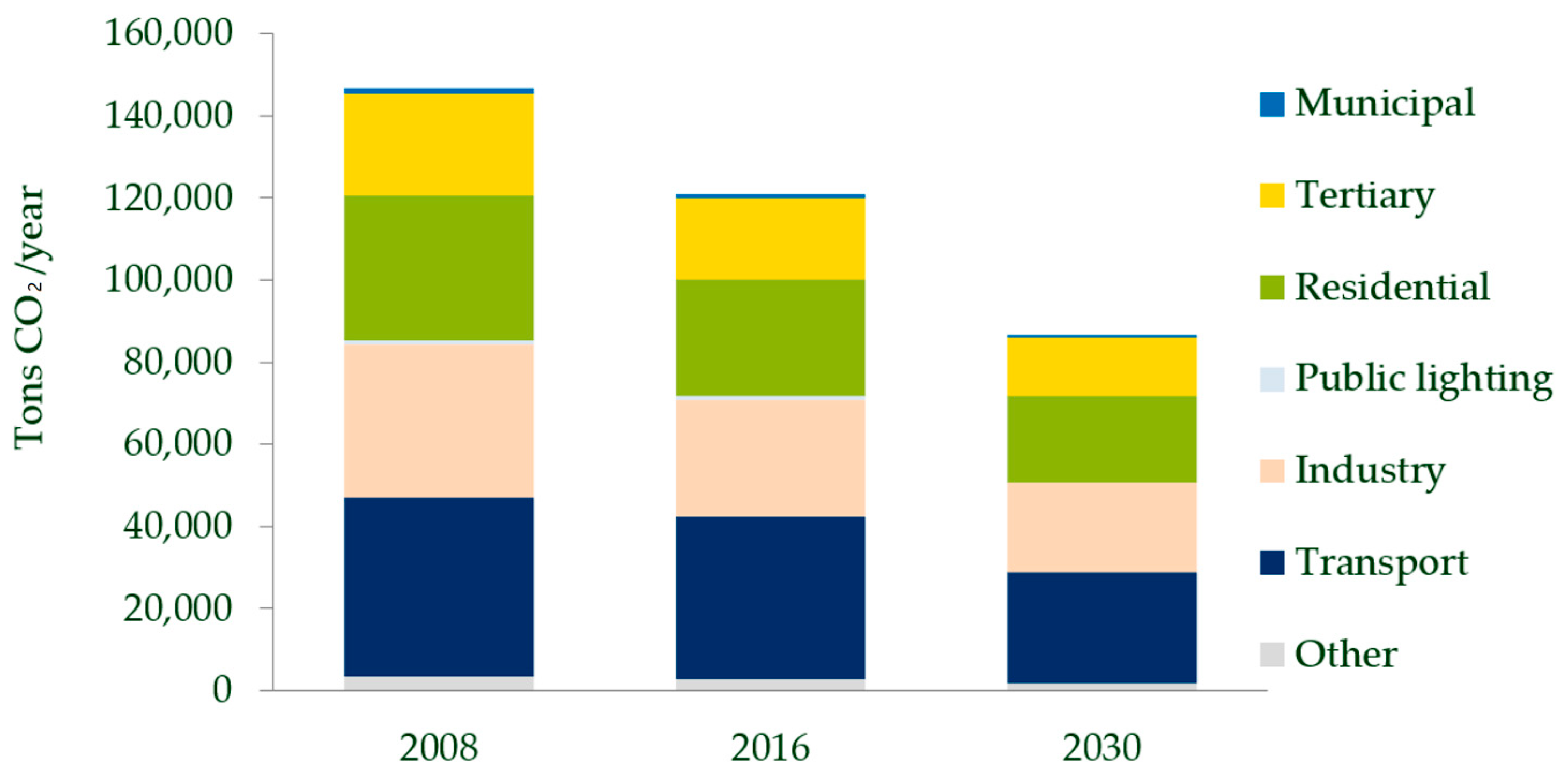
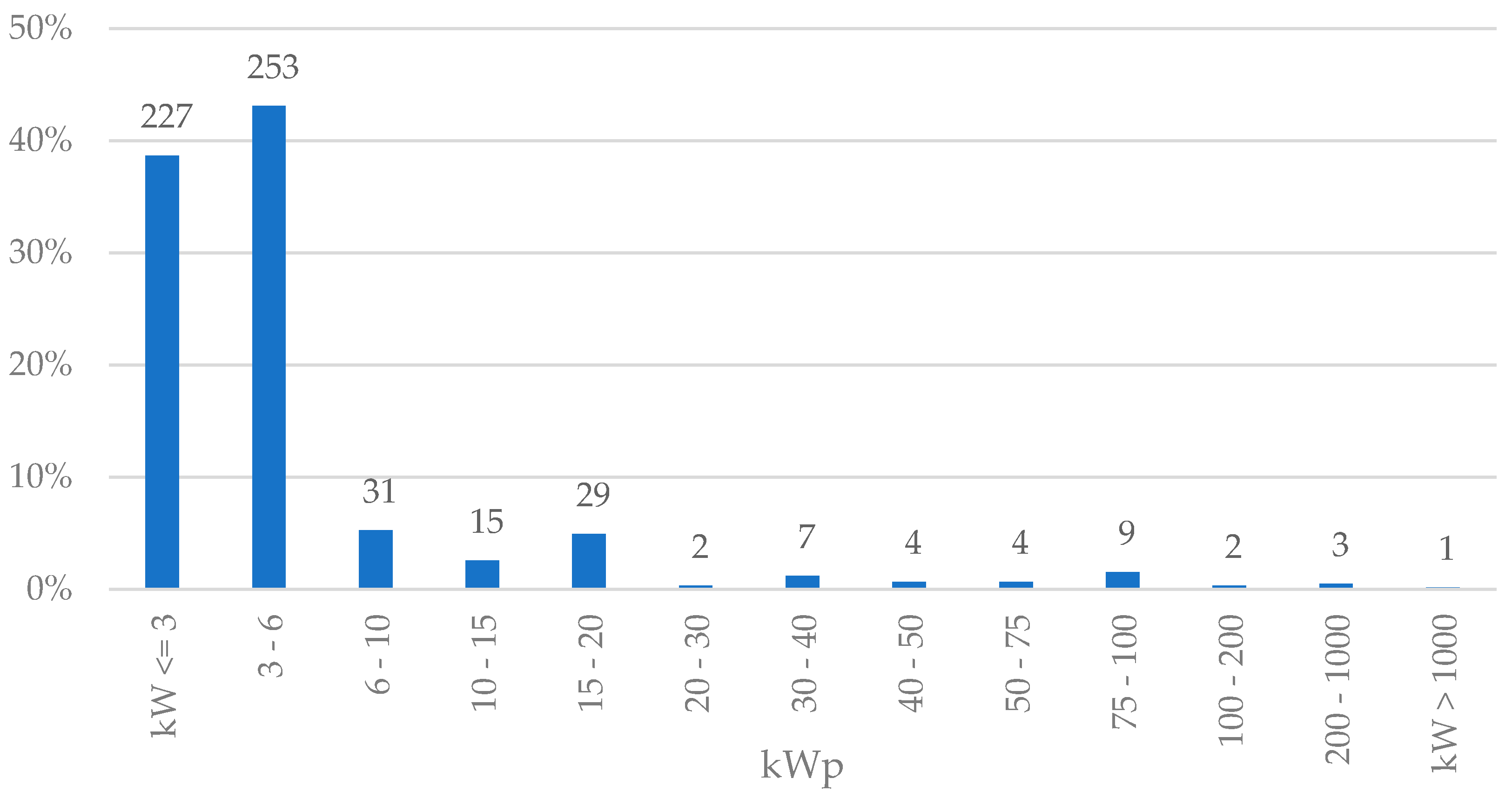
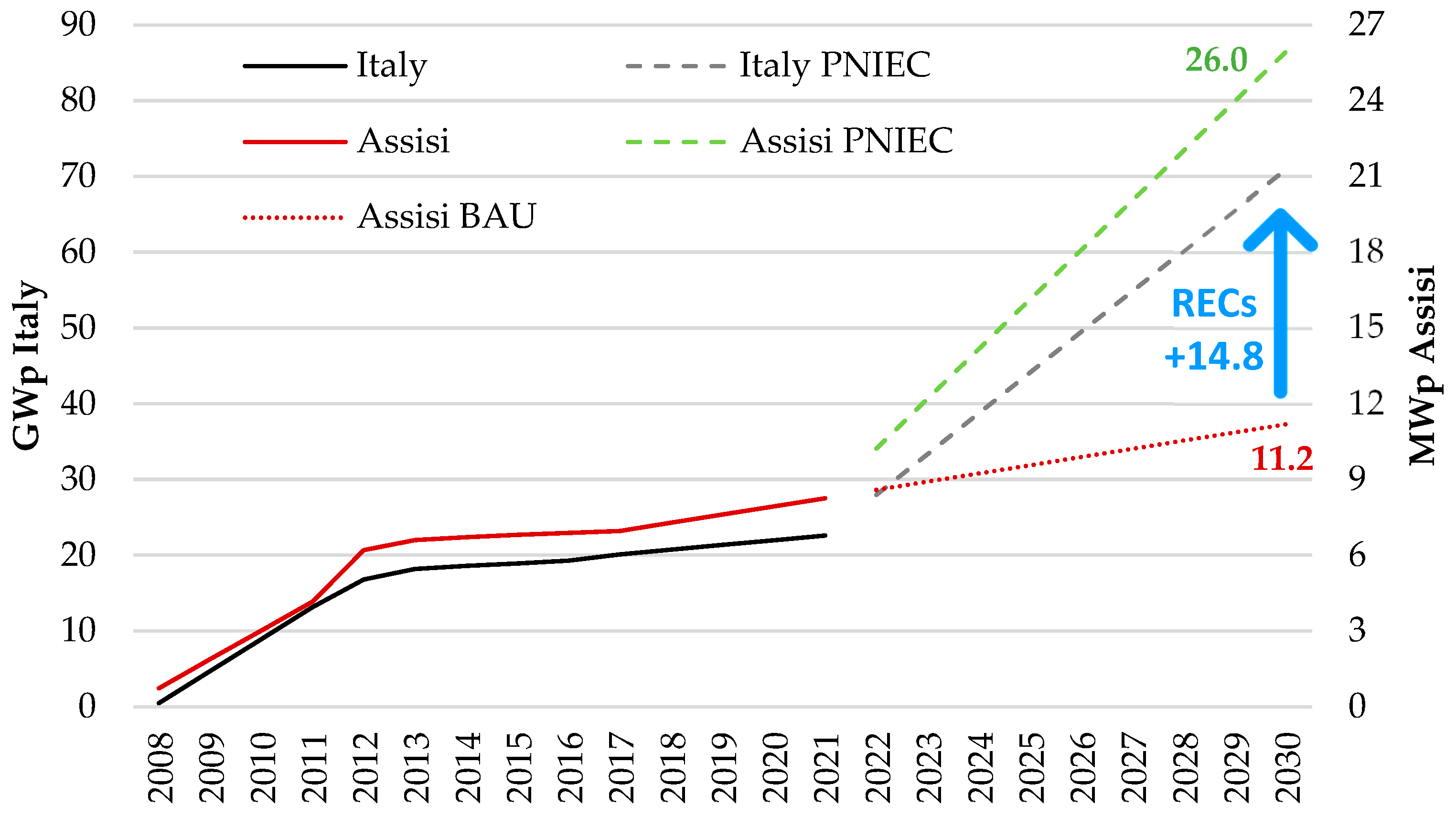

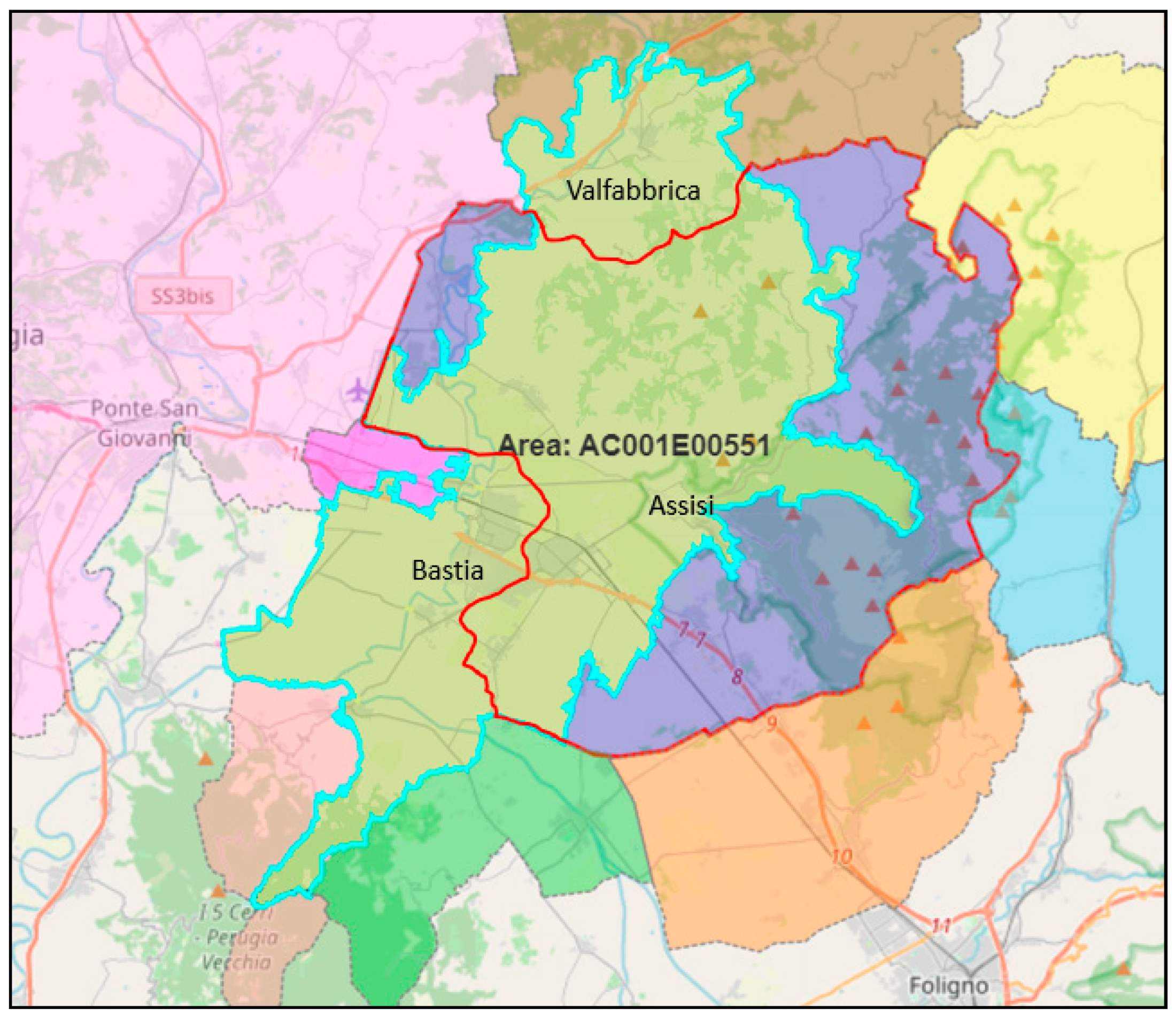

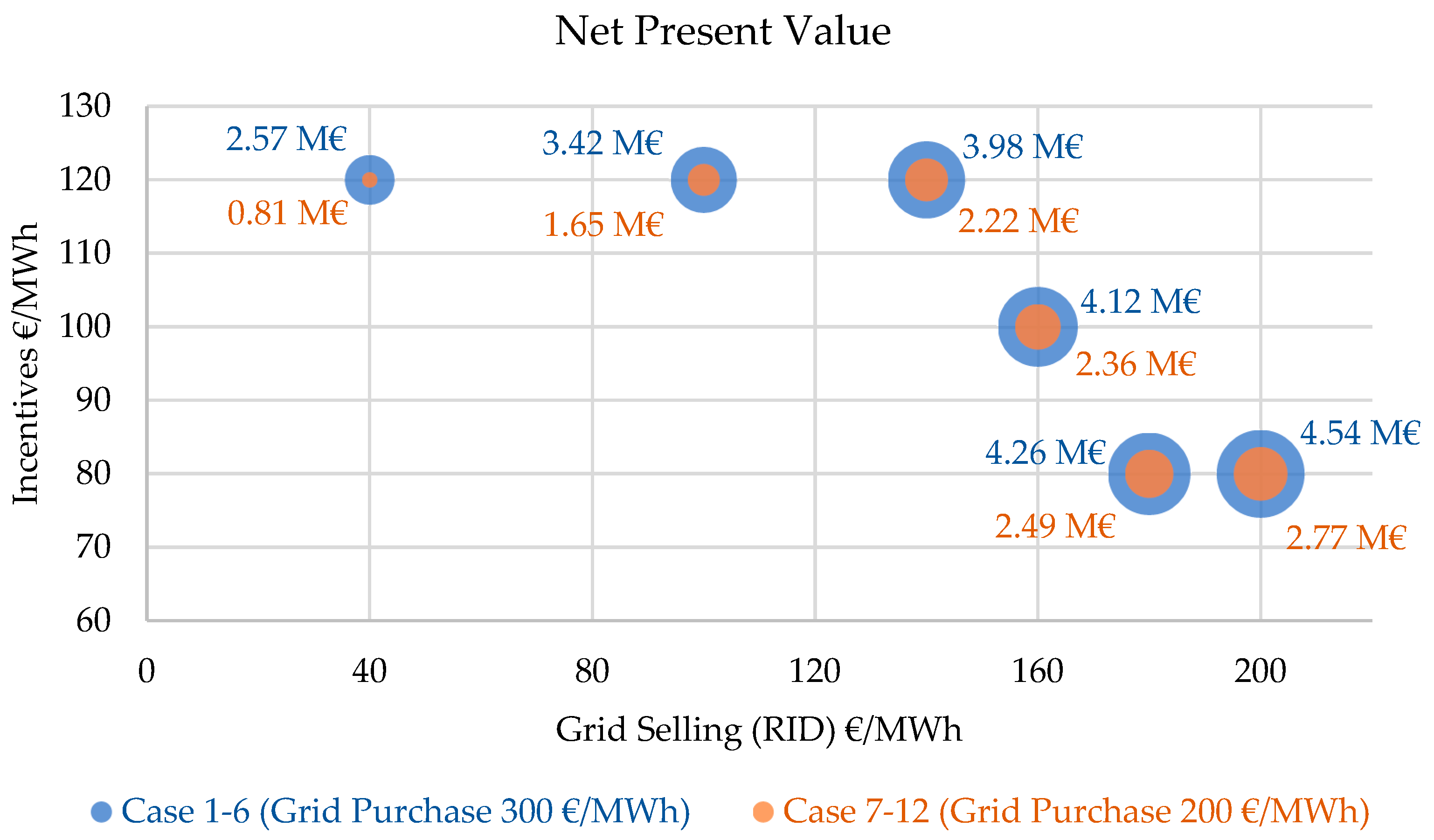
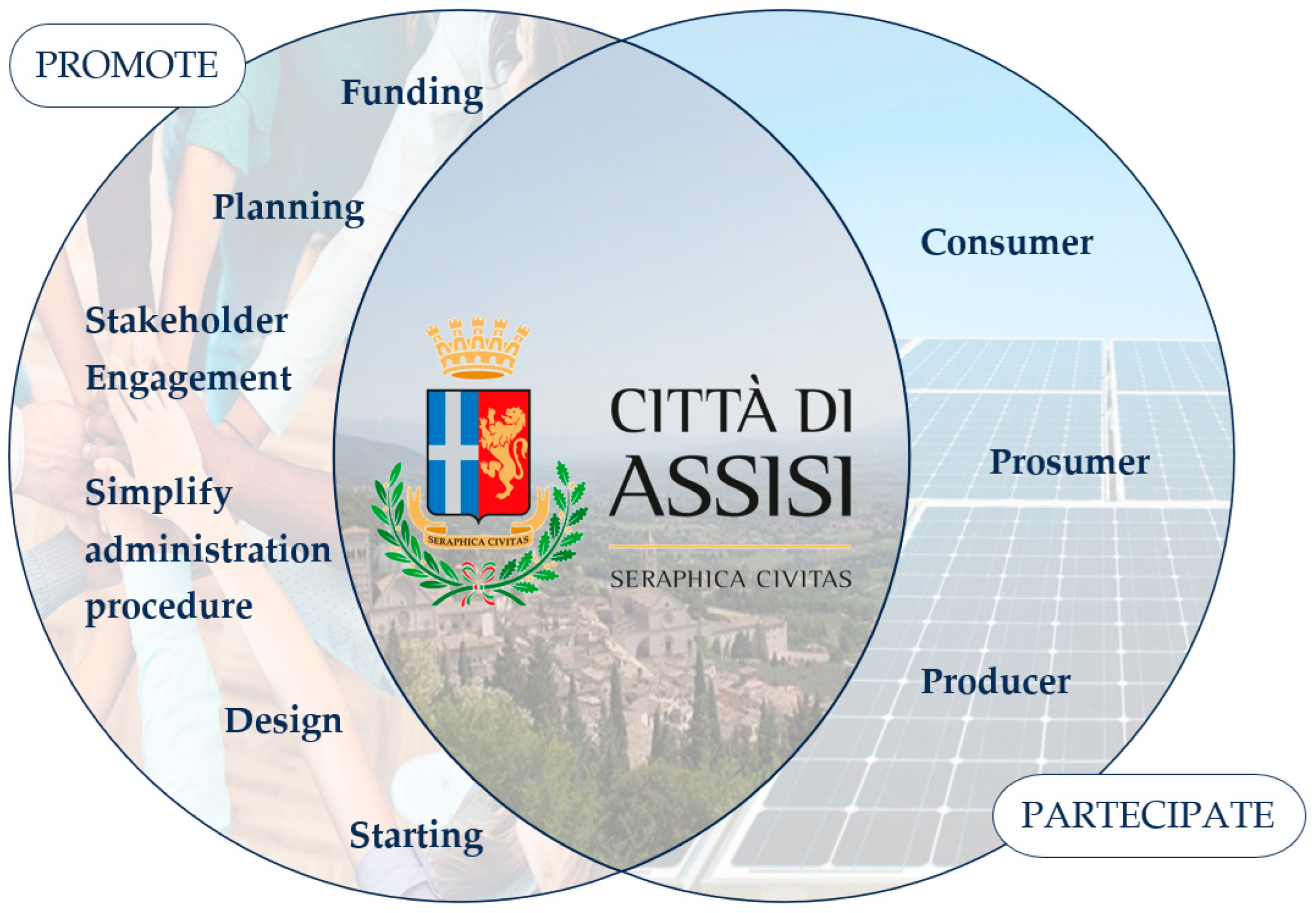

| Cluster | Type of Users | Number of Users | Peak Power Photovoltaic Systems 1 (kWp) | Annual Electricity Consumption 2 (kWh) |
|---|---|---|---|---|
| P | Producer | 1 | 50 | - |
| A | Prosumer | 5 | 199 | 1,000,000 |
| B | Prosumer | 5 | 99 | 500,000 |
| C | Prosumer | 4 | 50 | 200,000 |
| D | Prosumer | 10 | 10 | 100,000 |
| E | Prosumer | 40 | 4 | 120,000 |
| M | Consumer | 23 | - | 1,021,940 |
| R | Consumer | 200 | - | 600,000 |
| Total | 288 | 2000 | 3,556,680 |
| Parameter | Value 1 |
|---|---|
| Energy consumption (MWh) | 3557 |
| Photovoltaic production (MWh) | 2392 |
| Physical self-consumption (MWh) | 1219 |
| Physical self-consumption index (%) | 51.0 |
| Energy fed into the grid (MWh) | 1173 |
| Energy fed into the grid (% of production) | 49.0 |
| Energy withdrawn (MWh) | 2338 |
| Shared energy (MWh) | 651 |
| Shared energy (% of grid fed in) | 55.5 |
| Virtual self-consumption index (%) | 27.2 |
| Total self-consumption index (%) | 78.2 |
| Energy self-sufficiency index (%) | 52.6 |
| Parameter | Annual Value |
|---|---|
| Tons of oil equivalent saved | 447 |
| Tons of CO2 avoided | 610 |
| Parameter | Value |
|---|---|
| CAPEX (EUR) | 2,973,180 |
| OPEX (EUR/yr) | 88,140 |
| OPEX in the 10th year (EUR) | 384,930 |
| Revenue from energy sales (RID) (EUR/yr) | 45,990 |
| Physical self-consumption (EUR/yr) | 380,990 |
| Revenue from incentive of shared energy (EUR/yr) | 74,010 |
| Parameter | Annual Value |
|---|---|
| Net Present Value (NPV) (EUR) | 2,575,707 |
| Simple Payback Period (year) | 10 |
| Discounted Payback Period (year) | 11 |
| Internal Rate of Return (IRR) (%) | 13.94 |
| Case ID | Grid Purchase (EUR/MWh) | PZ (RID) (EUR/MWh) | Incentives (EUR/MWh) | NPV (EUR) | Simple Payback Period (Year) |
|---|---|---|---|---|---|
| 1 | 300 | 40 | 120 | 2,572,969 | 10 |
| 2 | 100 | 120 | 3,419,483 | 9 | |
| 3 | 140 | 120 | 3,983,826 | 9 | |
| 4 | 160 | 100 | 4,120,277 | 9 | |
| 5 | 180 | 80 | 4,256,729 | 9 | |
| 6 | 200 | 80 | 4,538,900 | 8 | |
| 7 | 200 | 40 | 120 | 808,142 | 14 |
| 8 | 100 | 120 | 1,654,656 | 12 | |
| 9 | 140 | 120 | 2,218,998 | 11 | |
| 10 | 160 | 100 | 2,355,450 | 10 | |
| 11 | 180 | 80 | 2,491,901 | 10 | |
| 12 | 200 | 80 | 2,774,073 | 10 |
| Scenario | Physical Self- Consumption Index | Shared Energy (% of Grid Fed in) | Total Self- Consumption Index |
|---|---|---|---|
| Base | 51% | 56% | 78% |
| Intermediate | 63% | 75% | 91% |
| Optimal | 70% | 100% | 100% |
| Parameter | Base Scenario (Case 8) | Intermediate Scenario | Optimal Scenario | Best-Case Scenario |
|---|---|---|---|---|
| Net Present Value (NPV) (EUR) | 1,654,656 | 2,086,965 | 2,420,223 | 5,316,254 |
| Simple Payback Period (year) | 12 | 11 | 10 | 8 |
| Discounted Payback Period (year) | 13 | 12 | 11 | 8 |
| Internal Rate of Return (IRR) (%) | 10.37% | 12.08% | 13.37% | 24.76% |
Disclaimer/Publisher’s Note: The statements, opinions and data contained in all publications are solely those of the individual author(s) and contributor(s) and not of MDPI and/or the editor(s). MDPI and/or the editor(s) disclaim responsibility for any injury to people or property resulting from any ideas, methods, instructions or products referred to in the content. |
© 2023 by the authors. Licensee MDPI, Basel, Switzerland. This article is an open access article distributed under the terms and conditions of the Creative Commons Attribution (CC BY) license (https://creativecommons.org/licenses/by/4.0/).
Share and Cite
Moretti, E.; Stamponi, E. The Renewable Energy Communities in Italy and the Role of Public Administrations: The Experience of the Municipality of Assisi between Challenges and Opportunities. Sustainability 2023, 15, 11869. https://doi.org/10.3390/su151511869
Moretti E, Stamponi E. The Renewable Energy Communities in Italy and the Role of Public Administrations: The Experience of the Municipality of Assisi between Challenges and Opportunities. Sustainability. 2023; 15(15):11869. https://doi.org/10.3390/su151511869
Chicago/Turabian StyleMoretti, Elisa, and Ettore Stamponi. 2023. "The Renewable Energy Communities in Italy and the Role of Public Administrations: The Experience of the Municipality of Assisi between Challenges and Opportunities" Sustainability 15, no. 15: 11869. https://doi.org/10.3390/su151511869
APA StyleMoretti, E., & Stamponi, E. (2023). The Renewable Energy Communities in Italy and the Role of Public Administrations: The Experience of the Municipality of Assisi between Challenges and Opportunities. Sustainability, 15(15), 11869. https://doi.org/10.3390/su151511869







